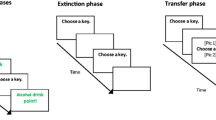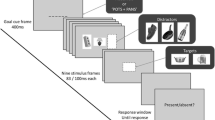Abstract
Rationale
Heavy alcohol drinking increases the incentive salience of alcohol-related cues. This leads to increased appetitive motivation to drink alcohol as measured by subjective craving and cognitive biases such as attentional bias and approach bias. Although these measures relate to the same construct, correlations between these variables are often very low. Alcohol consumption might not only increase different aspects of appetitive motivation, but also correlations between those aspects.
Objectives
To investigate the effect of a low alcohol dose on changes in various measures of appetitive motivation.
Materials and methods
Twenty-three heavy social drinkers were tested in 2 sessions, once after receiving an alcohol prime dose and once after receiving a placebo drink. After drink administration, attentional bias was measured with a visual-probe task using concurrent eye movement monitoring. Furthermore, we measured the approach bias with a stimulus response compatibility task and subjective craving with the Desires for Alcohol Questionnaire.
Results
After the alcohol prime dose, participants had higher levels of craving and more pronounced attentional bias (faster reaction times to probes that replaced alcohol rather than control pictures, increased maintenance of gaze on alcohol pictures, and a higher percentage of first eye movements directed toward alcohol pictures). Approach bias was not influenced by the alcohol prime dose. The correlation between attentional bias and approach bias was significantly higher after the alcohol than after the placebo drink.
Conclusions
A low alcohol dose increased most measures of appetitive motivation for alcohol and increased the interrelation between cognitive measures of this construct.
Similar content being viewed by others
References
Babor TF, Higgins-Biddle JC, Saunders JB, Monteiro MG (2001) AUDIT: the alcohol use disorders identification test, guidelines for use in primary care, 2nd edn. World Health Organization, Geneva
Bradley B, Field M, Mogg K, De Houwer J (2004) Attentional and evaluative biases for smoking cues in nicotine dependence: component processes of biases in visual orienting. Behav Pharmacol 15:29–36
Chutuape MAD, Mitchell SH, de Wit H (1994) Ethanol preloads increase ethanol preference under concurrent random-ratio schedules in social drinkers. Exp Clin Psychopharmacol 2:310–318
De Houwer J, Crombez G, Baeyens F, Hermans D (2001) On the generality of the affective Simon effect. Cogn Emot 15:189–206
De Wit H, Chutuape MA (1993) Increased ethanol choice in social drinkers following ethanol preload. Behav Pharmacol 4:29–36
Duka T, Townshend JM (2004) The priming effect of alcohol pre-load on attentional bias to alcohol-related stimuli. Psychopharmacology 176:353–361
Duka T, Stephens DN, Russell C, Tasker R (1998) Discriminative stimulus properties of low doses of ethanol in humans. Psychopharmacology 136:379–389
Edwards G (1996) Sensible drinking. BMJ 312:1
Ehrman RN, Robbins SJ, Bromwell MA, Lankford ME, Monterosso JR, O’Brien CP (2002) Comparing attentional bias to smoking cues in current smokers, former smokers, and non-smokers using a dot-probe task. Drug Alcohol Depend 67:185–191
Field M, Duka T (2002) Cues paired with a low dose of alcohol acquire conditioned incentive properties in social drinkers. Psychopharmacology 159:325–334
Field M, Eastwood B (2005) Experimental manipulation of attentional bias increases the motivation to drink alcohol. Psychopharmacology 183:350–357
Field M, Mogg K, Bradley BP (2004a) Eye movements to smoking-related cues: effects of nicotine deprivation. Psychopharmacology 173:116–123
Field M, Mogg K, Zetteler J, Bradley BP (2004b) Attentional biases for alcohol cues in heavy and light social drinkers: the roles of initial orienting and maintained attention. Psychopharmacology 176:88–93
Field M, Mogg K, Bradley BP (2005a) Alcohol increases cognitive biases for smoking cues in smokers. Psychopharmacology 180:63–72
Field M, Mogg K, Bradley BP (2005b) Craving and cognitive biases for alcohol cues in social drinkers. Alcohol Alcohol 40:504–510
Field M, Eastwood B, Bradley BP, Mogg K (2006) Selective processing of cannabis cues in regular cannabis users. Drug Alcohol Depend 85:75–82
Field M, Duka T, Eastwood B, Child R, Santarcangelo M, Gayton M (2007a) Experimental manipulation of attentional biases in heavy drinkers: do the effects generalize? Psychopharmacology 192:593–608
Field M, Kiernan A, Eastwood B, Child R (2007b) Rapid approach responses to alcohol cues in heavy drinkers. J Behav Ther Exp Psychiatry, in press, doi:10.1016/j.jbtep.2007.06.001
Fillmore MT, Vogel Sprott M (1999) An alcohol model of impaired inhibitory control and its treatment in humans. Exp Clin Psychopharmacol 7:49–55
Fillmore MT, Vogel Sprott M (2000) Response inhibition under alcohol: effects of cognitive and motivational conflict. J Stud Alcohol 61:239–246
Fillmore MT, Vogel Sprott M (2006) Acute Effects of Alcohol and Other Drugs on Automatic and Intentional Control. In: Wiers RW, Stacy AW (eds) Handbook of implicit cognition and addiction. Sage, Thousand Oaks, CA, pp 293–306
Fillmore MT, Vogel Sprott M, Gavrilescu D (1999) Alcohol effects on intentional behavior: dissociating controlled and automatic influences. Exp Clin Psychopharmacol 7:372–378
Franken IHA (2003) Drug craving and addiction: integrating psychological and neuropsychopharmacological approaches. Prog Neuropsychopharmacol Biol Psychiatry 27:563–579
Franken IH, Kroon LY, Hendriks VM (2000a) Influence of individual differences in craving and obsessive cocaine thoughts on attentional processes in cocaine abuse patients. Addict Behav 25:99–102
Franken IHA, Kroon LY, Wiers RW, Jansen A (2000b) Selective cognitive processing of drug cues in heroin dependence. J Psychopharmacol 14:395–400
Kirk JM, de Wit H (2000) Individual differences in the priming effect of ethanol in social drinkers. J Stud Alcohol 61:64–71
Koster EHW, Crombez G, Verschuere B, De Houwer J (2004) Selective attention to threat in the dot probe paradigm: differentiating vigilance and difficulty to disengage. Behav Res Ther 42:1183–1192
Lavender T, Hommel B (2007) Affect and action: towards an event-coding account. Cogn Emot 21:1270–1296
Love A, James D, Willner P (1998) A comparison of two alcohol craving questionnaires. Addiction 93:1091–1102
Markman AB, Brendl CM (2005) Constraining theories of embodied cognition. Psychol Sci 16:6–10
Mogg K, Bradley BP, Field M, De Houwer J (2003) Eye movements to smoking-related pictures in smokers: relationship between attentional biases and implicit and explicit measures of stimulus valence. Addiction 98:825–836
Mogg K, Field M, Bradley BP (2005) Attentional and approach biases for smoking cues in smokers: an investigation of competing theoretical views of addiction. Psychopharmacology 180:333–341
Noel X, Colmant M, Van der Linden M, Bechara A, Bullens Q, Hanak C, Verbanck P (2006) Time course of attention for alcohol cues in abstinent alcoholic patients: the role of initial orienting. Alcohol Clin Exp Res 30:1871–1877
Payne BK (2005) Conceptualizing control in social cognition: how executive functioning modulates the expression of automatic stereotyping. J Pers Soc Psychol 89:488–503
Robinson TE, Berridge KC (1993) The neural basis of drug craving: a incentive-sensitization theory of addiction. Brain Res Rev 18:247–291
Robinson TE, Berridge KC (2000) The psychology and neurobiology of addiction: a incentive-sensitization view. Addiction 95:S91–S117
Saunders JB, Aasland OG, Babor TF, de la Fuente JR, Grant M (1993) Development of the Alcohol Use Disorders Identification Test (AUDIT): WHO collaborative project on early detection of persons with harmful alcohol consumption: II. Addiction 88:791–804
Sayette MA, Monti PM, Rohsenow DJ, Gulliver SB et al (1994) The effects of cue exposure on reaction time in male alcoholics. J Stud Alcohol 55:629–633
Schoenmakers T, Wiers RW, Jones BT, Bruce G, Jansen A (2007) Attentional retraining decreases attentional bias in heavy drinkers without generalization. Addiction 102:399–405
Sobell LC, Sobell MB (1990) Self-report issues in alcohol abuse: sate of the art and future directions. Behav Assess 12:77–90
Steiger JH (1980) Tests for comparing elements of a correlation matrix. Psychol Bull 87:245–251
Stormark KM, Field NP, Hugdahl K, Horowitz M (1997) Selective processing of visual alcohol cues in abstinent alcoholics: an approach-avoidance conflict? Addict Behav 22:509–519
Townshend JM, Duka T (2001) Attentional bias associated with alcohol cues: differences between heavy and occasional social drinkers. Psychopharmacology 157:67–74
Townshend JM, Duka T (2007) Avoidance of alcohol-related stimuli in alcohol-dependent inpatients. Alcohol Clin Exp Res 31:1–9
van den Wildenberg E, Beckers M, van Lambaart F, Conrod PJ, Wiers RW (2006) Is the strength of implicit alcohol associations correlated with alcohol-induced heart-rate acceleration? Alcohol Clin Exp Res 30:1336–1348
Wiers RW, Bartholow BD, van den Wildenberg E, Thush C, Engels RCME, Sher KJ, Grenard J, Ames SL, Stacy AW (2007) Automatic and controlled processes and the development of addictive behaviors in adolescents: a review and a model. Pharmacol Biochem Behav 86:263–283
Acknowledgements
We would like to thank Elizabeth Tyler and Paul Christiansen for their help during testing, Fren Smulders for his contribution to devising the experimental design, and Gerard van Breukelen for his statistical advice. We would also like to thank the N.W.O. (Netherlands Organization for Scientific Research) for the Vidi-Grant 452.02.005 awarded to Reinout W. Wiers and the Medical Research Council Grant GO601070 awarded to Matt Field.
Author information
Authors and Affiliations
Corresponding author
Rights and permissions
About this article
Cite this article
Schoenmakers, T., Wiers, R.W. & Field, M. Effects of a low dose of alcohol on cognitive biases and craving in heavy drinkers. Psychopharmacology 197, 169–178 (2008). https://doi.org/10.1007/s00213-007-1023-5
Received:
Accepted:
Published:
Issue Date:
DOI: https://doi.org/10.1007/s00213-007-1023-5




